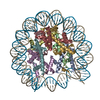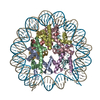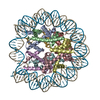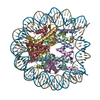[English] 日本語
 Yorodumi
Yorodumi- PDB-9k3z: Cryo-EM structure of Arabidopsis thaliana H2A.Z-nucleosome with A... -
+ Open data
Open data
- Basic information
Basic information
| Entry | Database: PDB / ID: 9k3z | ||||||
|---|---|---|---|---|---|---|---|
| Title | Cryo-EM structure of Arabidopsis thaliana H2A.Z-nucleosome with Arabidopsis native 147bp DNA 15.2.2 (C2 symmetry) | ||||||
 Components Components |
| ||||||
 Keywords Keywords | NUCLEAR PROTEIN/DNA / nucleosome / histone / H2A.Z / Arabidopsis / NUCLEAR PROTEIN-DNA complex | ||||||
| Function / homology |  Function and homology information Function and homology informationchromocenter / thylakoid / response to water deprivation / plasmodesma / plant-type vacuole / plastid / response to temperature stimulus / chloroplast / structural constituent of chromatin / peroxisome ...chromocenter / thylakoid / response to water deprivation / plasmodesma / plant-type vacuole / plastid / response to temperature stimulus / chloroplast / structural constituent of chromatin / peroxisome / nucleosome / regulation of gene expression / protein heterodimerization activity / nucleolus / DNA binding / extracellular region / nucleus / plasma membrane / cytosol Similarity search - Function | ||||||
| Biological species |  | ||||||
| Method | ELECTRON MICROSCOPY / single particle reconstruction / cryo EM / Resolution: 2.75 Å | ||||||
 Authors Authors | Wang, Y. / Dong, A. | ||||||
| Funding support |  China, 1items China, 1items
| ||||||
 Citation Citation |  Journal: Structure / Year: 2025 Journal: Structure / Year: 2025Title: Structural and functional interrelationships of histone H2A with its variants H2A.Z and H2A.W in Arabidopsis. Authors: Youchao Wang / Jiabing Wu / Shuoming Yang / Xiang Li / Jiachen Wang / Qinghe Lv / Xiaoyu Zhu / Guoliang Lu / Jinru Zhang / Wen-Hui Shen / Bing Liu / Jinzhong Lin / Aiwu Dong /   Abstract: Multiple histone H2A variants are known in eukaryotes. However, the functional relationship between H2A and its variants in plants remains largely obscure. Using CRISPR-Cas9 editing, we generated a ...Multiple histone H2A variants are known in eukaryotes. However, the functional relationship between H2A and its variants in plants remains largely obscure. Using CRISPR-Cas9 editing, we generated a mutant lacking four H2A isoforms in Arabidopsis and analyzed the functional and structural relationships between H2A, H2A.Z, and H2A.W. RNA sequencing and phenotype analyses revealed mild changes in gene transcription and plant development in mutants lacking H2A, H2A.Z, or H2A.W compared with the wild-type plants. Chromatin immunoprecipitation sequencing analysis showed that H2A can substitute for both H2A.Z and H2A.W across the genome, including in euchromatin and heterochromatin regions. However, H2A.Z replaced both H2A and H2A.W primarily within the euchromatin regions. By using DNA and histones from Arabidopsis, we constructed nucleosomes containing H2A, H2A.Z, or H2A.W and resolved their cryogenic electron microscopy (cryo-EM) structures at near-atomic resolution. Collectively, the results reveal the structural similarity and functional redundancy of H2A and its variants in Arabidopsis. | ||||||
| History |
|
- Structure visualization
Structure visualization
| Structure viewer | Molecule:  Molmil Molmil Jmol/JSmol Jmol/JSmol |
|---|
- Downloads & links
Downloads & links
- Download
Download
| PDBx/mmCIF format |  9k3z.cif.gz 9k3z.cif.gz | 310.4 KB | Display |  PDBx/mmCIF format PDBx/mmCIF format |
|---|---|---|---|---|
| PDB format |  pdb9k3z.ent.gz pdb9k3z.ent.gz | 234.9 KB | Display |  PDB format PDB format |
| PDBx/mmJSON format |  9k3z.json.gz 9k3z.json.gz | Tree view |  PDBx/mmJSON format PDBx/mmJSON format | |
| Others |  Other downloads Other downloads |
-Validation report
| Summary document |  9k3z_validation.pdf.gz 9k3z_validation.pdf.gz | 407.9 KB | Display |  wwPDB validaton report wwPDB validaton report |
|---|---|---|---|---|
| Full document |  9k3z_full_validation.pdf.gz 9k3z_full_validation.pdf.gz | 417 KB | Display | |
| Data in XML |  9k3z_validation.xml.gz 9k3z_validation.xml.gz | 17.5 KB | Display | |
| Data in CIF |  9k3z_validation.cif.gz 9k3z_validation.cif.gz | 29.1 KB | Display | |
| Arichive directory |  https://data.pdbj.org/pub/pdb/validation_reports/k3/9k3z https://data.pdbj.org/pub/pdb/validation_reports/k3/9k3z ftp://data.pdbj.org/pub/pdb/validation_reports/k3/9k3z ftp://data.pdbj.org/pub/pdb/validation_reports/k3/9k3z | HTTPS FTP |
-Related structure data
| Related structure data |  62034MC  9k40C  9k41C  9k42C  9k43C M: map data used to model this data C: citing same article ( |
|---|---|
| Similar structure data | Similarity search - Function & homology  F&H Search F&H Search |
- Links
Links
- Assembly
Assembly
| Deposited unit | 
|
|---|---|
| 1 |
|
- Components
Components
-Protein , 4 types, 8 molecules AEBFCGDH
| #1: Protein | Mass: 15300.968 Da / Num. of mol.: 2 Source method: isolated from a genetically manipulated source Source: (gene. exp.)  Gene: HTR2, At1g09200, T12M4.9, HTR3, At3g27360, K1G2.8, HTR13, At5g10390, F12B17_260, HTR9, At5g10400, F12B17_250, HTR1, At5g65360, MNA5.9 Production host:  #2: Protein | Mass: 11436.467 Da / Num. of mol.: 2 Source method: isolated from a genetically manipulated source Source: (gene. exp.)  Gene: At1g07660, F24B9.25, At1g07820, F24B9.8, At2g28740, F8N16.2, T11P11.4, At3g45930, F16L2_140, At3g46320, F18L15.40, At3g53730, F5K20_30, At5g59690, MTH12.10, At5g59970, MMN10.22 Production host:  #3: Protein | Mass: 14301.707 Da / Num. of mol.: 2 Source method: isolated from a genetically manipulated source Source: (gene. exp.)   #4: Protein | Mass: 16439.291 Da / Num. of mol.: 2 Source method: isolated from a genetically manipulated source Source: (gene. exp.)   |
|---|
-15.2.2 DNA (147- ... , 2 types, 2 molecules IJ
| #5: DNA chain | Mass: 45071.871 Da / Num. of mol.: 1 / Source method: obtained synthetically / Source: (synth.)  |
|---|---|
| #6: DNA chain | Mass: 45654.219 Da / Num. of mol.: 1 / Source method: obtained synthetically / Source: (synth.)  |
-Details
| Has protein modification | N |
|---|
-Experimental details
-Experiment
| Experiment | Method: ELECTRON MICROSCOPY |
|---|---|
| EM experiment | Aggregation state: PARTICLE / 3D reconstruction method: single particle reconstruction |
- Sample preparation
Sample preparation
| Component | Name: Arabidopsis thaliana H2A.Z-nucleosome with Arabidopsis native 147bp DNA 15.2.2 Type: COMPLEX / Entity ID: all / Source: RECOMBINANT |
|---|---|
| Source (natural) | Organism:  |
| Source (recombinant) | Organism:  |
| Buffer solution | pH: 7.4 |
| Specimen | Conc.: 1 mg/ml / Embedding applied: NO / Shadowing applied: NO / Staining applied: NO / Vitrification applied: YES |
| Vitrification | Cryogen name: ETHANE |
- Electron microscopy imaging
Electron microscopy imaging
| Experimental equipment |  Model: Titan Krios / Image courtesy: FEI Company |
|---|---|
| Microscopy | Model: TFS KRIOS |
| Electron gun | Electron source:  FIELD EMISSION GUN / Accelerating voltage: 300 kV / Illumination mode: FLOOD BEAM FIELD EMISSION GUN / Accelerating voltage: 300 kV / Illumination mode: FLOOD BEAM |
| Electron lens | Mode: BRIGHT FIELD / Nominal defocus max: 1800 nm / Nominal defocus min: 900 nm / Alignment procedure: COMA FREE |
| Specimen holder | Cryogen: NITROGEN / Specimen holder model: FEI TITAN KRIOS AUTOGRID HOLDER |
| Image recording | Electron dose: 50 e/Å2 / Film or detector model: GATAN K3 (6k x 4k) |
- Processing
Processing
| EM software |
| ||||||||||||||||
|---|---|---|---|---|---|---|---|---|---|---|---|---|---|---|---|---|---|
| CTF correction | Type: NONE | ||||||||||||||||
| Symmetry | Point symmetry: C2 (2 fold cyclic) | ||||||||||||||||
| 3D reconstruction | Resolution: 2.75 Å / Resolution method: FSC 0.143 CUT-OFF / Num. of particles: 192738 / Symmetry type: POINT |
 Movie
Movie Controller
Controller







 PDBj
PDBj






































